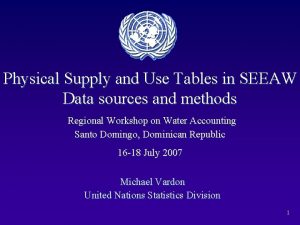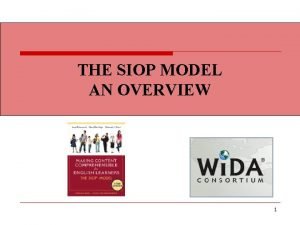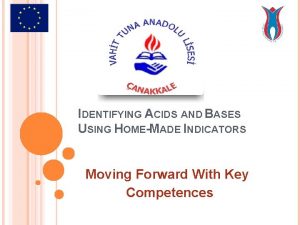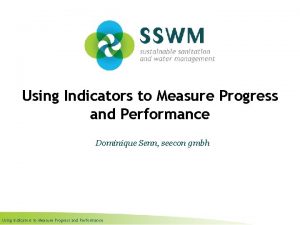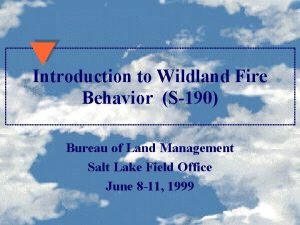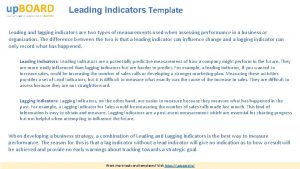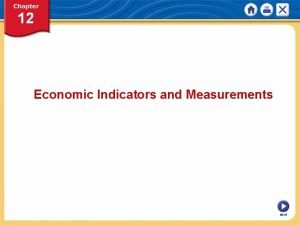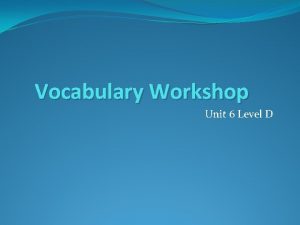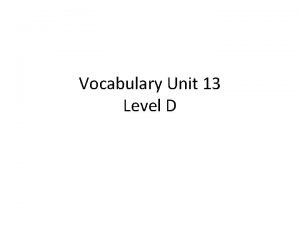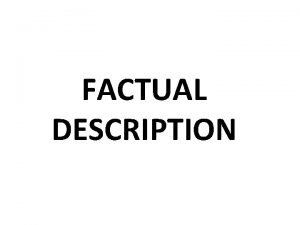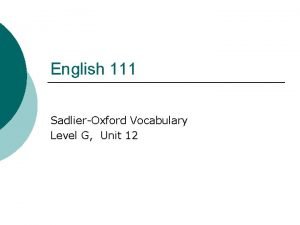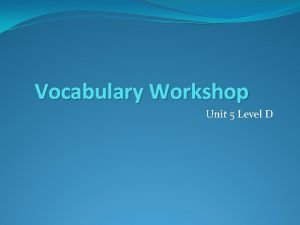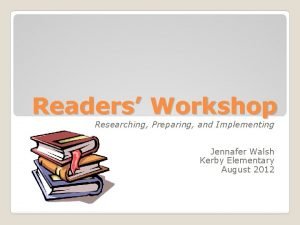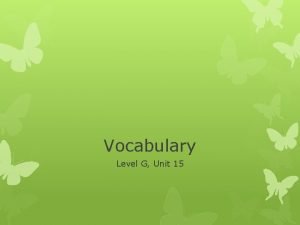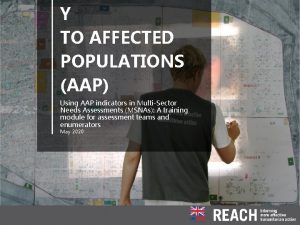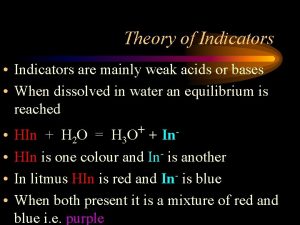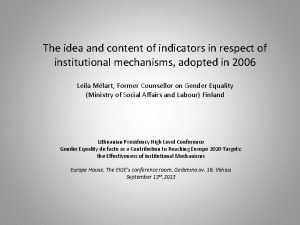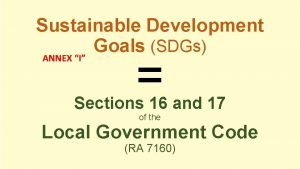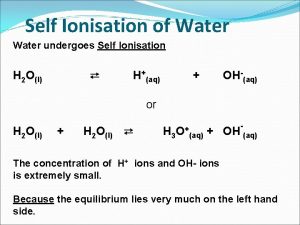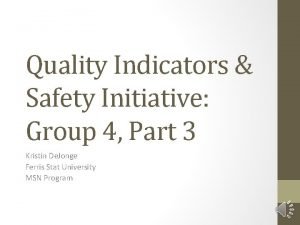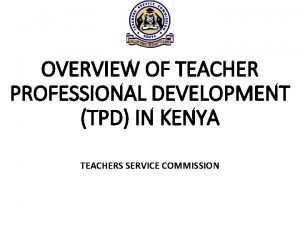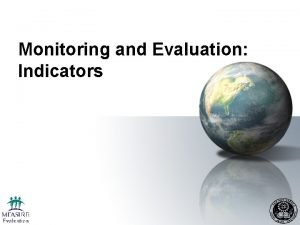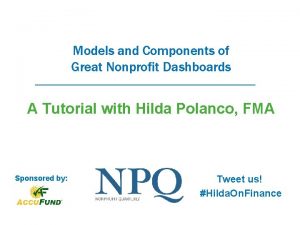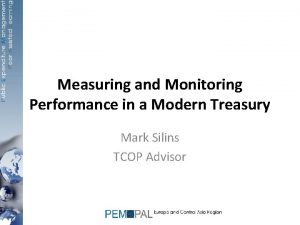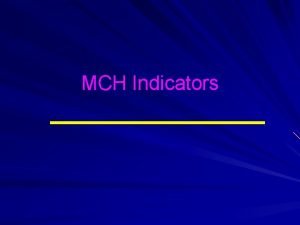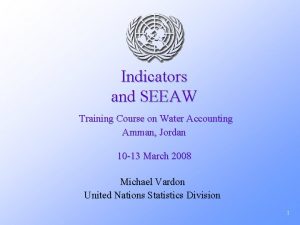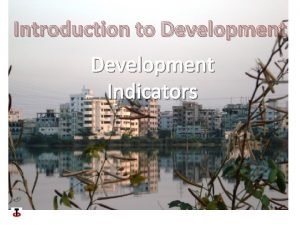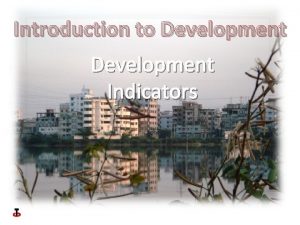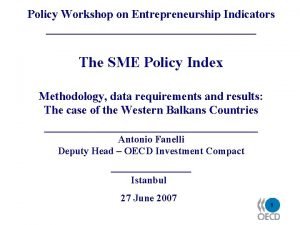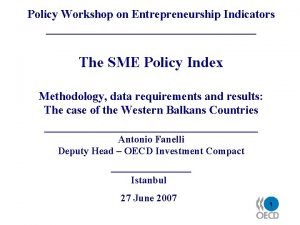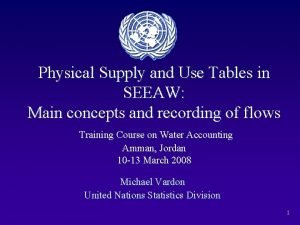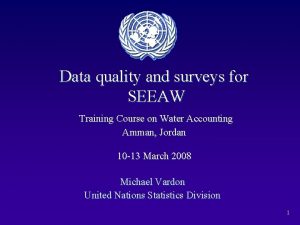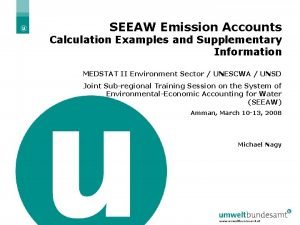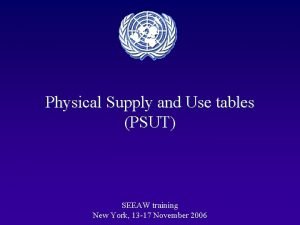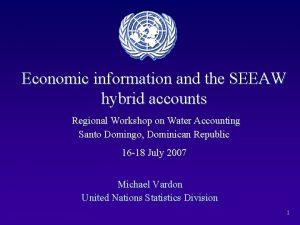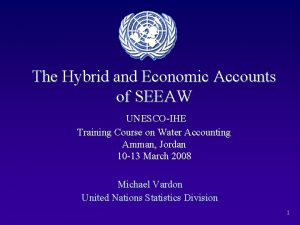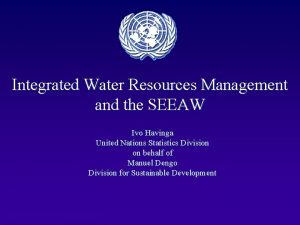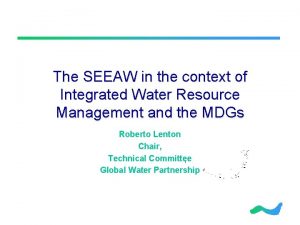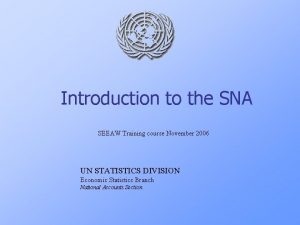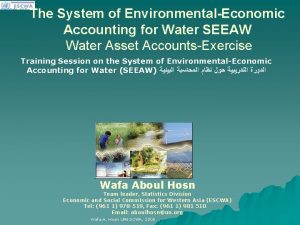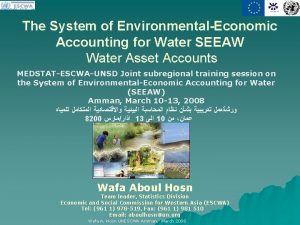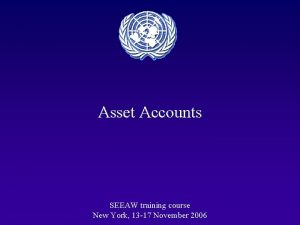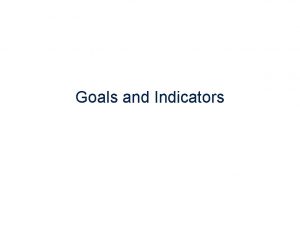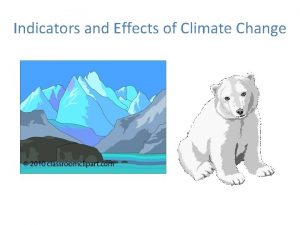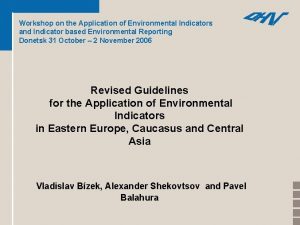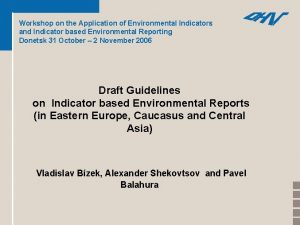Policy application of SEEAW and indicators Technical Workshop

































- Slides: 33

Policy application of SEEAW (and indicators) Technical Workshop on the Preparation of Water Accounts in Latin America Chile, 1 -4 June, 2009 Jeremy Webb United Nations Statistics Division 1

Outline • Relationship between the environment and economy • Data users for indicators and accounts • The SEEAW and Indicators • National examples • Summary 2

The environment and the economy • The relationship between the environment and the economy is complex – so is water data • We need to find a way to communicate complex information, e. g. • The environment provides: • Economic resources to production process (e. g. water and energy) • Non-economic resources to production process as well as other uses for mankind • Environment receives wastes from the economy 3

A model of the relationships between the environment and economy: Pressure – State – Response 4

Indicators • Indicators can be used to monitor: • Government goals, targets or benchmarks • Pressure, state, response • Driving forces, pressure, state, impact, response • Outputs and outcomes • Inputs, outcomes, impacts • etc… 5

Characteristics of indicators • Focus on outcomes • Have an unambiguous 'good' direction • Be supported by timely data of good quality • Be available as a time series • Be sensitive to changes • Be summary in nature • Be capable of disaggregation • Be interpreted easily by the general reader Adapted from Measures of Australia’s Progress 2002, and Indicator Guidelines (Statistics NZ) http: //www. abs. gov. au/AUSSTATS/abs@. nsf/94713 ad 445 ff 1425 ca 25682000192 af 2/aa 16 f 6 e 99 c 3078 bfca 256 bdc 001223 f 6!Open. Document http: //www. stats. govt. nz/products-and-services/user-guides/indicator-guidelines/default. htm 6

Data users, indicators and accounts Headline indicators Data users Indicators on different subjects or industries Decision makers & wider public Is there an issue? Yes Advice Research Managers and analysts Researchers Data users have different areas of responsibility: • water in the environment, • water supply and sanitation • agriculture, electricity gen. • manufacturing, tourism Indicators SEEA-W Standard tables Supplementary tables Data items Information 7

Data users, indicators and accounts Water in the environment e. g. Environment agency Water supply and sanitation e. g. Utilities or health agencies Industry specific water information e. g. Farmers or electricity generators Top level decision makers and the wider public Summary information e. g. National water indicators e. g. MDG WSS indicators e. g. Efficiency indicators by industry Decisions makers, managers and analysts Summary information along with supporting tables, graphs and maps that allow further analysis Researchers Detailed tables and in some cases levels of access to microdata (taking into consideration confidentiality) e. g. SEEA-W asset accounts e. g. SEEA-W Hydrid accounts e. g. PSUT and hybrid accounts e. g. Standard tables and in some cases microdata 8

Application of indicators and accounts • • We have identified data users We have identified areas of responsibility • How to match data to users? • What will data be used for? 9

Application of indicators and accounts • A lot of the information needed to address policy questions can be found in the SEEAW standard tables • Some questions require additional information • In some cases the standard tables can be expanded to include: • more detailed industry breakdowns • a lower level of geographic reference (e. g. province instead of state) • Some of additional data can be drawn from supplementary tables 10

The SEEAW and Indicators (pages 169 -183) SEEAW provides an annex on indicators: • Water availability • Water intensity and productivity • Opportunities to increase water supply • Cost and price of water supply and wastewater treatment services 11

Indicators of water availability • Per capita renewable resources • Ratio between Total renewable water resources and population size. (WWDR 2003, Margat 1996) • Annual Withdrawals of Ground and Surface Water as a Percent of Total Renewable Water/Exploitation index • The total annual volume of ground and surface water abstracted for water uses as a percentage of the total annually renewable volume of freshwater. (UN, 2001) • Consumption Index • Ratio between Water Consumption and Total 12 Renewable Resources. (Margat, 1996)

Per capita renewable resources from SEEAW Asset account Total renewable water resources ________ Population = 2. Returns + 3. Precipitation + 4. Inflows – 6. Evaporation – 7. Outflows ________ Population 13

Annual Withdrawals of Ground and Surface Water as a Percent of Total Renewable from SEEAW Withdrawals of ground and surface water ________ Total renewable water resources SEEAW Physical Use Table 1. i. 1 Abstraction from surface water + 1. i. 2 Abstraction from ground water = ________ SEEAW Asset account 2. Returns + 3. Precipitation + 4. Inflows – 6. Evaporation – 7. Outflows 14

Consumption Index from SEEAW Physical Supply Table Water consumption ________ Total renewable water resources = 7. Consumption ________ SEEAW Asset account 2. Returns + 3. Precipitation + 4. Inflows – 6. Evaporation – 7. Outflows 15

Indicators for water intensity and productivity from SEEAW 16

Indicators for opportunities to increase water supply from SEEA 17

Indicators for cost and price of water supply and wastewater treatment 18

Indicators of access to and affordability of water and sanitation services 19

Links between the World Water Development Report Indicators and SEEAW • World Water Assessment Programme 2006 • 21 of 38 Indicators can be directly derived from the water accounts • An 5 indicators can be partially derived • 12 cannot be derived but can be included as supplementary information. Of these • 4 are social indicators (e. g. urban and rural population) • 3 are related to land areas and could be derived from land accounts • 3 are related to energy and could be derived from energy accounts 20 • Remaining 2 relate to ISO 14001 certification

National examples of the application of water accounts • • China Australia Botswana Netherlands 21

Development of Water Accounting in China • Nov 2006 – Chinese delegation from the National Bureau of Statistics (NBS) and the Ministry of Water Resources (MWR) visit UN in New York for training on SEEAW • Jan-Mar 2007 Project committee formed – UNSD, NBS and MWR • Apr-July 2007 Pilot tables for physical supply use and emissions completed • Aug 2007 UN Mission to China to review pilot work • Sep-De 2007 Pilot tables for hybrid supply use and assets accounts completed. • Jan 2008 – Chinese delegation visit UN in New York for training on SEEAW In 14 months a great deal was achieved with existing data 22

Asset accounts for 10 regions Songhua Liaohe Northwest Rivers Haihe Yellow Southwest Rivers Huaihe Yangtze Southeast Rivers Pearl Water resources regions in China at the first class 23

Projecting future water demands Australia 2050 24

Australia Percentage of mean annual rainfall 1998 -99 to -2000 -01 Percentage of mean annual rainfall 2002 -03 to -2004 -05 25

Australia 2004 -05: monetary vs. physical use of distributed water (% of total use) Value of water Volume of water Source: ABS 2007. An Experimental Monetary Water Account for Australia 2004 -05: 26 http: //www. abs. gov. au/ausstats/abs@. nsf/mf/4610. 0. 55. 005

Botswana: water use and economic growth 1993 -1998 27

Netherlands: water pollution and economic growth, 1999 -2001 28

Summary • Indicators and accounts communicate complex information • Indicators and accounts can be presented in many ways, e. g. • • • Graphs Maps Tables 29

Summary • Indicators are important communication tools • they summarise complex information • Indicators are only as good as the data and accounts that underpin them • indicators need to be built on a solid foundation of data • Indicators flag possible issues but other information is required to analyse issues • indicators need to be interpreted analysed in the context of other data 30

Summary • All of levels of information are needed to have a complete information system • Because policy makers are not yet familiar with environment accounts, you may find it useful to conduct your own analysis of the accounts or to encourage others to do an analysis • Indicators and accounts cover a range of subjects/industries 31

Summary • Water indicators and the SEEAW can provide information on: • Macro trends (and decoupling) in: • total water use, • emissions, • water use by source and purpose, etc. • Industry-level trends • indicators used for environmental-economic profiles • Technology and driving forces • water intensity/productivity • total (domestic) water requirements to meet final demand • International transport of water and pollution 32

Contact details Jeremy Webb Statistician (Environment Statistics) United Nations Statistics Division New York 10017, USA Room DC 2 1410 Phone: +1 212 963 8564 Fax: +1 212 963 0623 Email: webbj@un. org Michael Vardon Adviser on Environmental-Economic Accounting United Nations Statistics Division New York 10017, USA Room DC 2 1532 Phone: +1 917 367 5391 Fax: +1 212 963 1374 Email: vardon@un. org 33
 Seeaw class
Seeaw class Application letter for workshop
Application letter for workshop Lesson preparation siop
Lesson preparation siop Class instructional support domain
Class instructional support domain Homemade indicators for acids and bases
Homemade indicators for acids and bases Chapter 7 sports and entertainment marketing
Chapter 7 sports and entertainment marketing What are cream and spiced indicators
What are cream and spiced indicators Identify three effects of low humidity s190
Identify three effects of low humidity s190 Leading and lagging indicators powerpoint template
Leading and lagging indicators powerpoint template Gdp types
Gdp types Vocabulary workshop level d unit 6 synonyms
Vocabulary workshop level d unit 6 synonyms Unit 13 level d
Unit 13 level d What is factual description
What is factual description Level f unit 12
Level f unit 12 Vocabulary workshop level d unit 5 antonyms
Vocabulary workshop level d unit 5 antonyms Bovine in a sentence
Bovine in a sentence Monty's noodles montmorency
Monty's noodles montmorency Pros and cons of reading workshop
Pros and cons of reading workshop Brazing hearth diagram
Brazing hearth diagram Vocab workshop level g unit 15
Vocab workshop level g unit 15 Sadlier level d unit 13 synonyms
Sadlier level d unit 13 synonyms Aap indicators
Aap indicators Indicators of potential workplace violence:
Indicators of potential workplace violence: Theory of indicators
Theory of indicators Respect indicators
Respect indicators Lgu scorecard indicators
Lgu scorecard indicators Theory of indicators
Theory of indicators Nursing sensitive indicators
Nursing sensitive indicators Tpd
Tpd Evaluation indicators examples
Evaluation indicators examples Evaluation indicators examples
Evaluation indicators examples Nonprofit financial dashboard
Nonprofit financial dashboard Treasury kpi metrics
Treasury kpi metrics Mch indicators
Mch indicators
